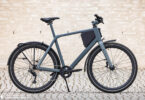With the Bosch Performance Line SX motor, the German manufacturer has unveiled a new drive unit that’s supposed to score points with its low system weight and natural ride feeling, thus allowing manufacturers to design lighter, more agile ebikes, both in town and beyond the city limits. We’ve already tested the motor for you to find out what it’s capable of and whether it’s only suitable for sporty riders.

More oomph, more capacity, more features – and more weight! To be able to compete in the current battery/motor arms race, many e-bike manufacturers are increasing the power of their motors and the size of the batteries. They do this partly to address the ever-spreading range anxiety, and partly to provide bikes that are suitable for a wide range of riding scenarios. Unfortunately, this comes at the expense of handling and ease of use, which isn’t just an issue with high-performance mountain bikes, but also in the urban sector – unless you have a big, comfortable garage where you can safely store your two-wheeled sweetheart. If you don’t, you’ll have to carry your bike upstairs into a flat or downstairs into a basement to charge it or to prevent it from getting stolen. And for commuters, finding a safe, easily accessible storage room at work isn’t always easy. Many manufacturers are aware of this, so we’re experiencing a shift in the way bikes are developed. As a result, we’re starting to see lighter, more nimble ebikes with hub motors being released on the market. At the same time, there are more and more bikes with mid-drive motors being launched, like the Canyon Roadlite:ON or Riese & Müller UBN Five, which both rely on a compact FAZUA Ride 60 drive system, and the Specialized Turbo Vado SL, which employs the Califiornian brand’s in-house drive system developed in close cooperation with MAHLE. For the upcoming season, market leader Bosch has finally joined the light motor party, launching the Bosch Performance Line SX. The new mid-drive motor is both smaller and lighter than any of Bosch’s current drives, but bulkier and less discreet than its direct competitors, the FAZUA, TQ and Specialized-MAHLE. It’s aimed primarily at sporty riders, and was developed specifically for light eMTBs, gravel bikes and urban bikes. For the U.S.A. and New Zealand market, Bosch have also released the Speed variant, which reaches a higher peak speed of 45 km/h. We were at Bosch’s e-bike development center to get all the details in advance and, of course, have already tested the new Bosch Performance Line SX on the trail (see E-MOUNTAINBIKE magazine) as well as in the urban jungle.



The new 2023 Bosch Performance Line SX motor in detail
With its unmistakable silver Bosch logo and red lettering, the Performance Line SX is distinctly recognizable as a Bosch motor. The drive is enclosed in a black magnesium housing, which has a similar shape to Bosch’s full-fat motor, the Performance Line CX. The Performance SX also relies on the same basic layout as its bigger brother, with the axle sitting right behind the motor rather than passing straight through it – as is the case with the TQ HPR 50 motor, for example. As a result, Bosch’s light motor isn’t as compact as other drives in its segment. Despite the visual similarities with the Performance Line CX drive, the SX motor offers less support, and forgoes a third support level. Due to the different gear ratio, the motor is most efficient at higher pedalling cadences, meaning that it delivers its full power when you pedal fast. As a result of the missing support level, the Bosch Performance SX is more compact than its full-fat Performance Line CX counterpart (around 20% smaller) and 750g lighter, tipping the scales at just 2.05 kg. The drive is an all-weather system with a protection rating of IP54. It’s compatible with 1x or 2x chainrings, and the Q-factor has been narrowed down from 178 mm to 160 mm to provide a more natural pedalling sensation, positioning the pedals closer together to replicate the feel of an analogue bike. Although the motor is lighter and more compact than its full-fat counterpart, it’s the smaller battery that really makes it a good match for slim city and fitness e-bikes. Overall, the new Bosch Performance Line SX isn’t the smallest drive on the market and doesn’t give manufacturers absolute freedom with frame designs. As a result, it can’t be integrated into the frame of city bikes as discreetly and seamlessly as a hub motor or the compact TQ and FAZUA mid-drive motors.


In terms of power, the Bosch Performance SX delivers 55 Nm of torque, with a peak output of up to 600 watts. That’s right, at peak – the motor doesn’t provide its maximum power continuously, but regulates it dynamically through the software, which calculates a moving average of the rider’s own power input. As long as you provide a certain average physical effort, the motor assists you with up to 40 Nm torque. If you pedal harder, exceeding your previous average, the motor churns out up to 55 Nm torque. As a result, you reach the peak power only in dynamic riding situations, whereby the software also ensures a good balance between natural ride feeling, decent range and de-rating, which is a decrease in power when the motor is under heavy load.

The new Bosch Performance SX motor features four riding modes with just as many support levels. Alongside Bosch’s classic riding modes, there’s a new progressive support mode called Sprint, which adjusts the assistance according to the pedalling cadence. Simply put, the faster you pedal, the more the motor assists you, with up to 280% support. This is meant to encourage you to work harder under your own steam, and at the same time adds to the sporty aspect of cycling. Turbo mode, on the other hand, provides up to 340% support. Ultimately, however, it’s up to bike manufacturers to decide which configuration suits their bikes best. Moreover, the eBike Flow app allows you to adjust the characteristics of the individual modes, including their dynamic behaviour, maximum torque, the strength of the support, and speed (within the framework of the legal regulations). Furthermore, the app provides training-specific data, like the amount of calories you burn while riding.

The battery options of the 2023 Bosch Performance Line SX motor.
Needless to say, the new Performance Line SX motor would be nothing without electricity. That’s why Bosch also introduced a brand-new battery, the CompactTube 400. As the name suggests, it has 400 Wh capacity and tips the scales at around 2 kg, bringing the total weight of the drive system (battery and motor) to just 4 kg.

If you want to use your bike for long commutes or epic weekend expeditions in the countryside, you can supplement the standard battery with the optional 250 Wh PowerMore range extender, which can be secured to the bottle cage mounts. This ensures a total battery capacity of 650 Wh, allowing you to keep up with many full-fat urban ebikes. The range extender weighs an additional 1.6 kg and is backwards-compatible with existing Smart System batteries, meaning that you can combine the Performance Line SX motor with, for example, the 500 Wh PowerTube 500 and all other Smart System batteries currently available on the market. Alternatively, the system can be charged via the new, compact 2 Ampere charger, which is meant to be 25% lighter and 40% more compact than Bosch’s 4 Amp standard charger – although it doesn’t charge as fast.

Display and remotes for the new 2023 Bosch Performance Line SX motor
With the Smart System’s Mini Remote and System Controller, Bosch have already proven that they take integration very seriously. The Performance Line SX too, relies on a modular concept, allowing for several different display/remote combos. The product family now also includes the new Purion 200 and Kiox 500 displays. Head over to our news to read to find out about their new functions, and to find out what else Bosch have in store for the new season.



The new 2023 Bosch Performance Line SX motor in our practical test
On paper, the Bosch Performance Line SX delivers 30 Nm less torque and a lower peak output than its bigger sibling, the Performance CX drive. In practice, however, this is still enough for most application areas. As a rule of thumb, motors with less torque make it harder to set off from a standstill on steep hills, but this also depends on the different characters of the motor, and the way it delivers its power. When riding on level ground, the Performance SX is an excellent option for both your average cyclist with a lower pedalling cadence and sporty riders who like to pedal fast. In the new sprint mode, the motor assistance feels disproportionately strong for sporty riders with a high pedalling cadence. See a gap in the traffic? Challenge accepted! Right from the first pedal stroke, the new Bosch Performance Line SX motor delivers its power willingly and pushes noticeably harder than its direct competitors, the FAZUA Ride 60 and TQ HPR 50 motor. However, the boisterous character changes as soon as you hit a climb in the wrong gear and have to negotiate it with a lower pedalling cadence. Here you notice that the motor struggles to deliver its power at lower cadences. If you work harder, making your way up the hill at higher cadences, the motor rewards you with more powerful assistance, making it easier to reach the required cadence for optimal power delivery. The Performance Line SX delivers a very natural ride feeling, with the smooth transition above the 25 km/h threshold contributing significantly to the experience, making it easy to surf the green wave through the city and to cruise down cycling paths in the countryside.



While in visual terms, the Performance SX might be less discreet than other light motors, it’s impressively quiet, working discreetly in the background at slow cadences of around 50 RPMs, allowing you to thread your way through narrow back streets without making a noise. With increasing cadences and higher loads, for example when hitting an unexpected climb, the motor emits a faint whirring sound. However, this isn’t at all annoying and is quickly drowned out by surrounding traffic. When you get home, the lightweight drive system makes it easy to carry your bike upstairs into a flat or downstairs into a basement. All in all, the new SX motor is neither a pioneer nor a leader in innovation, but rather a sensible combination of light and full-power motor.

Our conclusions about the new Bosch Performance Line SX
The Bosch Performance Line SX drive system is neither the lightest nor the slimmest e-bike motor available on the market.. On the other hand, it’s more powerful than many other light mid-drive motors, and therefore offers a good compromise, bridging the gap between light and full-power motors. While the optimal cadence range isn’t suited for beginners and leisurely riders, it’s more than enough in most urban riding situations. For bike manufacturers, the modular concept enables countless battery/remote/display configurations, while end users benefit from the excellent connectivity.
Tops
- Natural ride feeling
- Modular concept
- High level of connectivity
Flops
- Less discrete and harder to integrate than its direct competitors
- Little support at low cadences
For more information, visit bosch-ebike.com

Words: Mike Hunger Photos: Mike Hunger, Peter Walker







